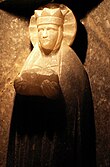Wieliczka Salt Mine
| UNESCO World Heritage Site | |
|---|---|
 | |
| Criteria | Cultural: iv |
| Reference | 32 |
| Inscription | 1978 (2nd Session) |
| Endangered | 1989-1998 |
The Wieliczka Salt Mine, located in the town of Wieliczka in southern Poland, lies within the Kraków metropolitan area. The mine continuously produced table salt from the 13th century until 2007 as one of the world's oldest operating salt mines (the oldest being the Bochnia Salt Mine).
The mine's attractions for tourists include dozens of statues and an entire cathedral that have been carved out of the rock salt by the miners. About 1.2 million persons visit the Wieliczka Salt Mine annually.
Commercial mining was discontinued in 1996 due to low salt prices and mine flooding.
Touring
The Wieliczka salt mine reaches a depth of 327 meters and is over 300 km long. It features a 3.5-km touring route for visitors (less than 1% of the length of the mine's passages) that includes historic statues and mythical figures. The oldest sculptures were carved out of rock salt by miners; more recent figures have been fashioned by contemporary artists. Even the crystals of the chandeliers are made from rock salt that has been dissolved and reconstituted to achieve a clear, glass-like appearance. The rock salt is naturally grey in various shades, so that the carvings resemble unpolished granite rather than the white or crystalline look that many visitors expect. The carvings may appear white in the photos, but the actual carved figures are not white.
At the end of the tour, there is a large cathedral and reception room that can be reserved for private functions such as weddings or private parties. Also featured is a large chamber with walls carved to resemble wooden chapels built by miners in earlier centuries; an underground lake; and exhibits on the history of salt mining. The Wieliczka mine is often referred to as "the Underground Salt Cathedral of Poland." It also houses a private rehabilitation and wellness complex.
Over the centuries, visitors to this site have included Nicolaus Copernicus, Johann Wolfgang von Goethe, Alexander von Humboldt, Dmitri Mendeleyev, Bolesław Prus, Ignacy Paderewski, Robert Baden-Powell, Jacob Bronowski (who filmed segments of The Ascent of Man in the mine), Karol Wojtyła (the later Pope John Paul II), former U.S. President Bill Clinton, and many others. During World War II, the salt mine was used by the occupying Germans as facilities for war-related industries.
To get down to the 64-metre level of the mine, visitors must descend a wooden stairway of 378 steps. After the three-kilometer tour of the mine's corridors, chapels, statues and lake, 135 metres underground, visitors take an elevator back up to the surface. The elevator holds 36 persons (nine per car) and takes some 30 seconds to reach the surface.
The salt mine helped inspire the Labyrinth scenes in Bolesław Prus' 1895 historical novel, Pharaoh.[1]
In 1978 the Wieliczka salt mine was placed on the original UNESCO list of the World Heritage Sites.
Photo tour
| Wieliczka Salt Mine | |||
 headframe |
 carved in rock salt |
 carved in a wall of rock salt |
 |
| Salt statue of Pope John Paul II of Pope John Paul II |
 in the museum |
 St Kinga's Shaft |
 at St Kinga's Chapel |
Sister caves
 Frasassi Caves [2] (Genga - Marche, Italy)
Frasassi Caves [2] (Genga - Marche, Italy)
See also
- Pharaoh ("Inspirations") — explanation of the Wieliczka Salt Mine's inspiration for the historical novel by Bolesław Prus
- Bochnia Salt Mine
- Chełm Chalk Tunnels
- Salt Cathedral of Zipaquirá, in Zipaquirá, Cundinamarca, Colombia
Notes
- ^ Christopher Kasparek, "Prus' Pharaoh and the Wieliczka Salt Mine," The Polish Review, 1997, no. 3, pp. 349–55.
- ^ Sister caves of Frasassi listed on www.frasassi.com
References
- Jerzy Grzesiowski, Wieliczka: kopalnia, muzeum, zamek (Wieliczka: the Mine, the Museum, the Castle), 2nd ed., updated and augmented, Warsaw, Sport i Turystyka, 1987, ISBN 83-217-2637-2.
- Christopher Kasparek, "Prus' Pharaoh and the Wieliczka Salt Mine," The Polish Review, 1997, no. 3, pp. 349–55.
External links
- More about Wieliczka Salt mine
- Wieliczka Salt Mine - UNESCO World Heritage Centre
- Wieliczka salt mine
- Video tour of mine
- Ancient salt-works
- Cracow Salt-Works Museum in Wieliczka (plan of mine)
- Wieliczka Salt Mine near Krakow in Poland
- Air Pollution Intrusion into the Wieliczka Salt Mine
- "A Piece of Salt that Weighs 200 Tons" fallen from Wieliczka chamber roof in 1916; Popular Science monthly, Feb 1916, page 179. Scanned by Google Books.
